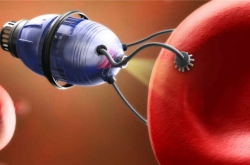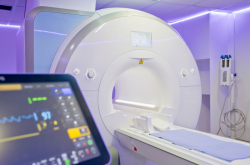Nanotube-based materials have multiple applications from diagnosis and treatment of diseases to cooling systems in electronics. However, it is challenging to obtain materials with certain characteristics without a deep understanding of their properties. Scientists usually study nanotubes with atomic force microscopy based on scanning a sample surface with a special probe. The probe is a needle with a tip apex a thousand times smaller than a micron. It moves along the surface, and the probe-sample interaction force is registered point-by-point. Simultaneously, a computer forms a three-dimensional image of the surface and tracks the sample electromechanical properties. With conventional scanning methods, the probe is continuously in contact with the sample and, therefore, can cause significant damage to the fragile nanotubes loosely attached to a substrate.
To avoid damage, researchers from ITMO University, MIPT and the University of Aveiro in Portugal, together with colleagues from NT-MDT Spectrum Instruments, developed a novel method for atomic force microscopy. The main feature of the method is that during the scanning, the probe moves to the next measurement point above the sample without making contact with it.
"After each measurement, we move the probe away from the surface, shift the sample slightly, and then lower the tip onto a new point," explains Arseny Kalinin, the lead author of the article and a member of the NT-MDT Spectrum Instruments team. "Instead of scratching the surface, we gently touch it so that small loose objects remain intact. We can do it thanks to advanced measurement algorithms as well as high-speed electronics that records the interaction signals between the probe and the surface in the real time."
Scientists used a new method to study nanotubes made of a short peptide diphenylalanine. They measured the elasticity of peptide nanotubes and described how they behave in an electric field. Surprisingly, nanotubes showed spontaneous polarization, that is, a shift of positive and negative charges relative to each other outside an electric field. What is more, scientists for the first time managed to directly measure the piezoelectric response of the nanotubes. This signal characterizes the ability of an object to change in size under an electric field.
"The piezoelectric effect helps to transform an electrical signal into a mechanical one and vice versa. Microphones, ultrasound imagers, and tiny motors in cameras work based on this principle," continues Arseniy. "Usually piezoelectric and mechanical properties are measured separately. With this new method, we can do it simultaneously without destroying the objects under study."
Due to spontaneous polarization, peptide nanotubes may be used in compact cooling devices.
"It's impossible to increase the speed of computer chips without effective cooling," says Alexander Tselev, a co-leader of the international laboratory focused on materials and structures for energy converters at ITMO University. "For this purpose, we can use compact devices operating in a way similar to a conventional fridge. If we make such devices from nanotubes, we can significantly reduce their size. Our task is to study in detail the properties of nanotubes and learn how to use them efficiently."
Article: “An atomic force microscopy mode for nondestructive electromechanical studies and its application to diphenylalanine peptide nanotubes” Arseny Kalinin et al. Ultramicroscopy Nov. 21, 2017




